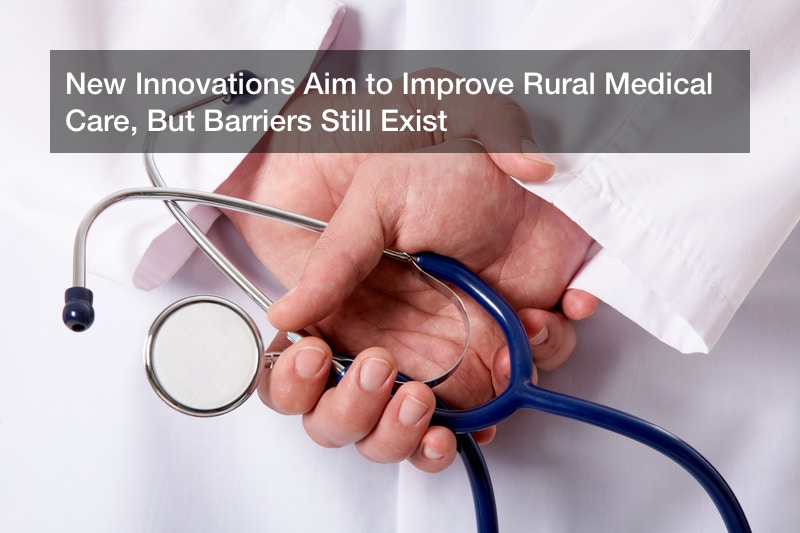
 Despite the sordid state of the American healthcare system, residents still rely on medical professionals to provide them with treatment when the worst occurs. After all, nearly 31 million injuries requiring medical attention occur every year across the nation. Unfortunately, the accessibility of this necessary care depends on a number of factors — including where you live. The reality for many of those who reside in rural areas is simply that medical treatment is hard to come by. And even though advancements are being made to fix the issue, it’s not clear whether those innovations will be enough to address the disparity.
Despite the sordid state of the American healthcare system, residents still rely on medical professionals to provide them with treatment when the worst occurs. After all, nearly 31 million injuries requiring medical attention occur every year across the nation. Unfortunately, the accessibility of this necessary care depends on a number of factors — including where you live. The reality for many of those who reside in rural areas is simply that medical treatment is hard to come by. And even though advancements are being made to fix the issue, it’s not clear whether those innovations will be enough to address the disparity.
According to recent data, countless citizens living in rural regions are forced to forgo healthcare due to the immense burden that accessing it would place on their daily lives. An NPR poll found that one in every four people living in rural areas said that they couldn’t get the care they needed, with a quarter of those individuals saying the reason was that the location of the healthcare facility was too far away or too difficult to access. While these results aren’t particularly surprising, seeing as over 100 rural hospitals have closed since 2010 and many more are in danger, they’re certainly discouraging.
As of December 2018, more than 7,000 areas throughout the U.S. were experiencing health professional shortages. Approximately 60% of those locales were situated in rural areas. And while affordability is a highly cited reason for those living in these areas to forgo medical attention, merely being able to physically travel to the facility is another inexcusable reason for Americans to refrain from the treatments they need.
When you realize that more than 97% of the entire United States can be considered rural and that these areas include nearly 20% of the nation’s population, it becomes clear that changes need to be made. But the wheels of progress turn slowly (or sometimes not at all). In Pennsylvania, nurse practitioners are fighting to bring their skills to underserved areas that are in desperate need of care. But they’re not allowed to practice if they can’t find a doctor with whom to partner. And even though Pennsylvania lawmakers have tried to move legislation forward that would eliminate that requirement, these bills have failed to pass in recent years because doctors’ associations oppose the measure. And while there are some valid concerns raised by these organizations, the failure to bring healthcare providers to these areas is making the medical professional shortage even worse.
Instead of relying on nurse practitioners, lawmakers in Nevada are attempting to provide incentive to rural doctors through Assembly Bill 358. If passed, the bill would encourage new doctors to relocate to smaller towns, as it would allow graduates from the University of Nevada, Reno and the University of Nevada, Las Vegas Schools of Medicine to obtain state-sponsored reimbursement for the tuition portion of their student loans. Their end of the bargain would require them to work in Nevada’s rural areas for five years. Since many rural hospitals and medical facilities are forced to close due to a lack of staffing, the initiative could very well have a positive impact. And since repaying student loans is a hot-button issue for many recent grads, it might be a win/win if the bill goes through.
Other innovations are being made to tackle the rural medicine problem, too. Despite the fact that the employment of medical lab technologists and technicians is anticipated to grow by 13% between now and 2026, the equipment and staff may not always be available in secluded areas. A potential solution? Traveling labs. Simulation in Motion, a non-profit that has partnered with Best Practice Medicine, has created three traveling medical labs that circulate throughout Montana to help healthcare providers at rural clinics and hospitals practice for medical emergencies. These labs can allow staff members to feel more confident in their skills, particularly because these rural facilities typically can’t afford to buy and maintain the kinds of equipment featured in the traveling labs. There are other types of traveling labs operating in different localities around the country, all with the purpose of providing training to staff members and ensuring increased access to equipment.
That said, these innovations alone will not solve the crisis currently happening in rural American healthcare. While isolated advancements show promise for widespread adoption, it’s clear that too many Americans have no available resources for medical treatment in close proximity. Unless government agencies and the medical community can find a way to keep rural hospitals open and open new healthcare facilities in these areas, accessibility will continue to be a serious issue for people all across the country.



